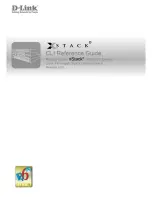
Chapter 4. Routing
|
263
ProSafe® Gigabit L3 Managed Stackable Switches Software Administration Manual
RIP Interface Configuration
1.
Use
Interface
to select the interface for which data is to be configured.
2.
Use
Send Version
to select the version of RIP control packets the interface should send
from the pull-down menu. The value is one of the following:
•
RIP-1
-Send RIP version 1 formatted packets via broadcast.
•
RIP-1c
-RIP version 1 compatibility mode. Send RIP version 2 formatted packets via
broadcast.
•
RIP-2
- Send RIP version 2 packets using multicast. The default is RIP-2.
•
None
- No RIP control packets will be sent.
3.
Use
Receive Version
to select what RIP control packets the interface will accept from the
pull-down menu. The value is one of the following:
•
RIP-1
- Accept only RIP version 1 formatted packets.
•
RIP-2
- Accept only RIP version 2 formatted packets. The default is RIP-2.
•
Both
- Accept packets in either format.
•
None
- No RIP control packets will be accepted.
4.
Use
RIP admin mode
to enable RIP for an interface. The default is Disable.
5.
Use
Authentication Type
to select an authentication type other than none by clicking on
the 'Configure Authentication' button. You will then see a new screen, where you can select
the authentication type from the pull-down menu. The choices are:
•
None
- This is the initial interface state. If you select this option from the pull-down
menu on the second screen you will be returned to the first screen and no
authentication protocols will be run.
•
Simple
- If you select 'Simple' you will be prompted to enter an authentication key.
This key will be included, in the clear, in the RIP header of all packets sent on the
network. All routers on the network must be configured with the same key.
•
Encrypt
- If you select 'Encrypt' you will be prompted to enter both an authentication
key and an authentication ID. Encryption uses the MD5 Message-Digest algorithm.
All routers on the network must be configured with the same key and ID.
6.
Use
Authentication Key
to enter the RIP Authentication Key for the specified interface. If
you do not choose to use authentication you will not be prompted to enter a key. If you
choose 'simple' or 'encrypt' the key may be up to 16 octets long. The key value will only be
displayed if you are logged on with Read/Write privileges.
7.
Use
Authentication Key ID
to enter the RIP Authentication Key ID for the specified
interface. If you choose not to use authentication or to use 'simple' you will not be prompted
to enter the key ID. If you choose 'encrypt' the key ID may be in range from 0 to 255. The
key ID value will be displayed only if you are logged on with Read/Write privileges.
8.
Click
CANCEL
to display a new screen where you can select the authentication method for
the virtual link.
















































